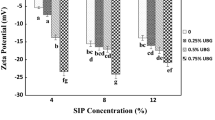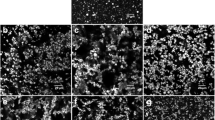Abstract
The present study compares the emulsifying properties in acidic conditions of hull soluble polysaccharides (HSPS), soybean soluble polysaccharides (SSPS) and its mixtures. These fractions were obtained from byproducts of soybean processing industry (soy hull and residual fiber after isolation of soy cotyledon protein, respectively). Although SSPS is already characterized, HSPS is a novel fraction which has not been studied in deep and it is still unexplored as emulsifier. Dispersions of both fraction and a mixture 50:50 of them at pH 3.0 were used as aqueous phase (1.0–3.0 % w/w) in coarse and fine oil-in-water emulsions (oil mass fraction = 0.3). Its stability was evaluated through the evolution of backscattering profiles (%BS), particle size distribution and mean particle diameters. The rheology of the emulsions was also analyzed. Both fractions provided stability to creaming when increasing the polysaccharide concentration and energy of homogenization. While coarse emulsions were unstable systems, fine emulsions were stable enough and allowed a deeper analysis of the destabilizing processes. A bridging flocculation phenomenon in the presence of HSPS and HSPS/SSPS mixtures is suggested, which influences the creaming and rheological behavior. Also, coalescence index increases according HSPS and HSPS/SSPS concentrations, but particle sizes reached were smaller than in SSPS emulsions. Fine emulsions with 3 % of HSPS/SSPS mixtures yielded the best results on the overall stability at 28 days. So, functional properties of the fractions may improve by the formulation of emulsions consisting in mixtures of them. These results are of interest to the manufacturing of acidic foods, taking advantage of obtaining byproducts from residual materials.







Similar content being viewed by others
Abbreviations
- HSPS:
-
Hull soluble polysaccharides
- SSPS:
-
Soybean soluble polysaccharides
- HSPS/SSPS:
-
Mixtures 50/50 of hull soluble polysaccharides and soybean soluble polysaccharides
- O/W emulsion:
-
Oil-in-water emulsion
- %BS profiles:
-
Profiles of backscattering
References
Akhtar M, Dickinson E, Mazoyer J, Langendorff V (2002) Emulsion stabilizing properties of depolymerized pectin. Food Hydrocoll 16:249–256
Aoki T, Decker EA, McClements DJ (2005) Influence of environmental stresses on stability of O/W emulsions containing droplets stabilized by multilayered membranes produced by a layer-by-layer electrostatic deposition technique. Food Hydrocoll 19:209–220
Blumenkrantz N, Asboe-Hansen G (1973) New method for quantitative determination of uranic acids. Anal Biochem 54:484–489
Cabezas DM, Madoery R, Diehl BWK, Tomás MC (2012) Emulsifying properties of different modified sunflower lecithins. J Am Oil Chem Soc 89:355–361
Cao Y, Dickinson E, Wedlock DJ (1990) Creaming and flocculation in emulsions containing polysaccharide. Food Hydrocoll 3:185–195
Cortés-Muñoz M, Chevalier-Lucia D, Dumay E (2009) Characteristics of submicron emulsions prepared by ultra-high-pressure homogenization: effect of chilled or frozen storage. Food Hydrocoll 23:640–654
Evans M, Ratcliffe I, Williams PA (2013) Emulsion stabilization using polysaccharide-protein complexes. Curr Opin Colloid Interface Sci 18:272–282
Gnanasambandam R, Proctor A (1999) Preparation of soy hull pectin. Food Chem 65:461–467
Hemar Y, Tamehana M, Munro PA, Singh H (2001) Influence of xanthan gum on the formation and stability of sodium caseinate oil-in-water emulsions. Food Hydrocoll 15:513–519
Higashitani K, Yoshida K, Tanise N, Muratac H (1993) Dispersion of coagulated colloids by ultrasonication. Colloids Surf A Physicochem Eng Asp 81:167–175
Hoogenkamp HW (2005) Soy protein essentials. In: Soy protein and formulated meat products. Cabi Publishing, Oxfordshire, pp 7–18
Kalapathy U, Proctor A (2001) Effect of acid extraction and alcohol precipitation conditions on the yield and purity of soy hull pectin. Food Chem 73:393–396
Kumar V, Rani A, Dixit AK, Pratap D, Bhatnagar D (2010) A comparative assessment of total phenolic content, ferric reducing-anti-oxidative power, free radical-scavenging activity, vitamin C and isoflavones content in soybean with varying seed coat colour. Food Res Int 43:323–328
Lira-Ortiz AL, Reséndiz-Vega F, Ríos-Leal E, Contreras-Esquivel JC, Chavarría-Hernández N, Vargas-Torres A, Rodríguez-Hernández AI (2014) Pectins from waste of prickly pear fruits (Opuntia albicarpa Scheinvar ‘Reyna’): chemical and rheological properties. Food Hydrocoll 37:93–99
Magdel-Din Hussein M, Helmy WA, Salem HM (1998) Biological activities of some galactomannans and their sulfated derivatives. Phytochemistry 48:479–484
Marquez AL, Wagner JR (2010) Rheology of double (W/O/W) emulsions prepared with soybean milk and fortified with calcium. J Texture Stud 41:651–671
Mc Clements DJ (1999) Food emulsions: principles, practice and techniques. CRC Press, Florida
Mc Clements DJ (2000) Comments on viscosity enhancement and depletion flocculation by polysaccharides. Food Hydrocoll 14:173–177
Monsoor MA (2005) Effect of drying methods on the functional properties of soy hull pectin. Carbohydr Polym 61:362–367
Nakamura A, Furuta H, Kato H, Maeda H, Ngamatsu Y (2003) Effect of soybean soluble polysaccharides on the stability of Milk protein under acidic conditions. Food Hydrocoll 17:333–343
Nakamura A, Takahashi T, Yoshida R, Maeda H, Corredig M (2004) Emulsifying properties of soybean soluble polysaccharide. Food Hydrocoll 18:795–803
Nakamura A, Fujii N, Tobe J, Adachi N, Hirotsuka M (2012) Characterization and functional properties of soybean high-molecular-mass polysaccharide complex. Food Hydrocoll 29:75–84
Nakauma M, Funami T, Noda S, Ishihara S, Al-Assaf S, Nishinari K, Phillips GO (2008) Comparison of sugar beet pectin, soybean soluble polysaccharide, and gum arabic as food emulsifiers. 1. Effect of concentration, pH, and salts on the emulsifying properties. Food Hydrocoll 22:1254–1267
Neirynck N, Van der Meeren P, Lukaszewicz-Lausecker M, Cocquyt J, Verbeken D, Dewettinck K (2007) Influence of pH and biopolymer ratio on whey protein-pectin interactions in aqueous solutions and in O/W emulsions. Colloids Surf A Physicochem Eng Asp 298:99–107
Nkonge C, Ballance GM (1982) A sensitive colorimetric procedure for nitrogen determination in Micro-Kjeldahl digests. J Agric Food Chem 30:416–420
Palazolo GG, Sorgentini DA, Wagner JR (2005) Coalescence and flocculation in o/w emulsions of native and denatured whey soy proteins in comparison with soy protein isolate. Food Hydrocoll 19:595–604
Ponce NMA, Ziegler VH, Stortz CA, Sozzi GO (2010) Compositional changes in cell wall polysaccharides from Japanese Plum (Prunus salicina Lindl.) during growth and on-tree ripening. J Agric Food Chem 58:2562–2570
Rodríguez R, Jiménez A, Fernández-Bolaños J, Guillén R, Heredia A (2006) Dietary fibre from vegetable products as source of functional ingredients. Trends Food Sci Technol 17:3–15
Santos PO, Santos IS, Gomes VM, Machado OLT, Fernandes KVS, Xavier-Filho J, Oliveira AEA (2008) In vitro evaluation of antifungal activity of soybean (Glycine max) seed coat proteins. J Stored Prod Res 44:310–315
Tripathi AK, Misra AK (2005) Soybean- a consummate functional food: a review. J Food Sci Technol 2:42–46
Walstra P (1996) Emulsion stability. In: Becher P (ed) Encyclopedia of emulsion technology, vol 4. Marcel Dekker, New York, pp 33–42
Acknowledgments
The authors of this article gratefully acknowledge the financial support of the Universidad Nacional de Quilmes (I+D Grant PUNQ 53/1007). Authors wish to thank Bunge Argentina S. A. (San Martín, Argentina) for kindly providing us the defatted soybean flour, and Lic. Matías Alancay (UNJu, Argentina) for helping with galacturonic acid determination.
Author information
Authors and Affiliations
Corresponding author
Additional information
Highlights
1. HSPS and SSPS were extracted from seed coat and cotyledon of soybean respectively
2. Both fractions were effective in the formulation and stabilization of acidic O/W emulsions
3. Higher concentrations stabilize emulsions to creaming and reduces mean droplet sizes
4. The presence of a mixture of the fractions improved the stability of the emulsions
5. This is of interest to the manufacturing of acidic foods making use of residual materials
María Cecilia Porfiri and Darío M. Cabezas contributed equally to this work.
Rights and permissions
About this article
Cite this article
Porfiri, M.C., Cabezas, D.M. & Wagner, J.R. Comparative study of emulsifying properties in acidic condition of soluble polysaccharides fractions obtained from soy hull and defatted soy flour. J Food Sci Technol 53, 956–967 (2016). https://doi.org/10.1007/s13197-015-2149-9
Revised:
Accepted:
Published:
Issue Date:
DOI: https://doi.org/10.1007/s13197-015-2149-9




